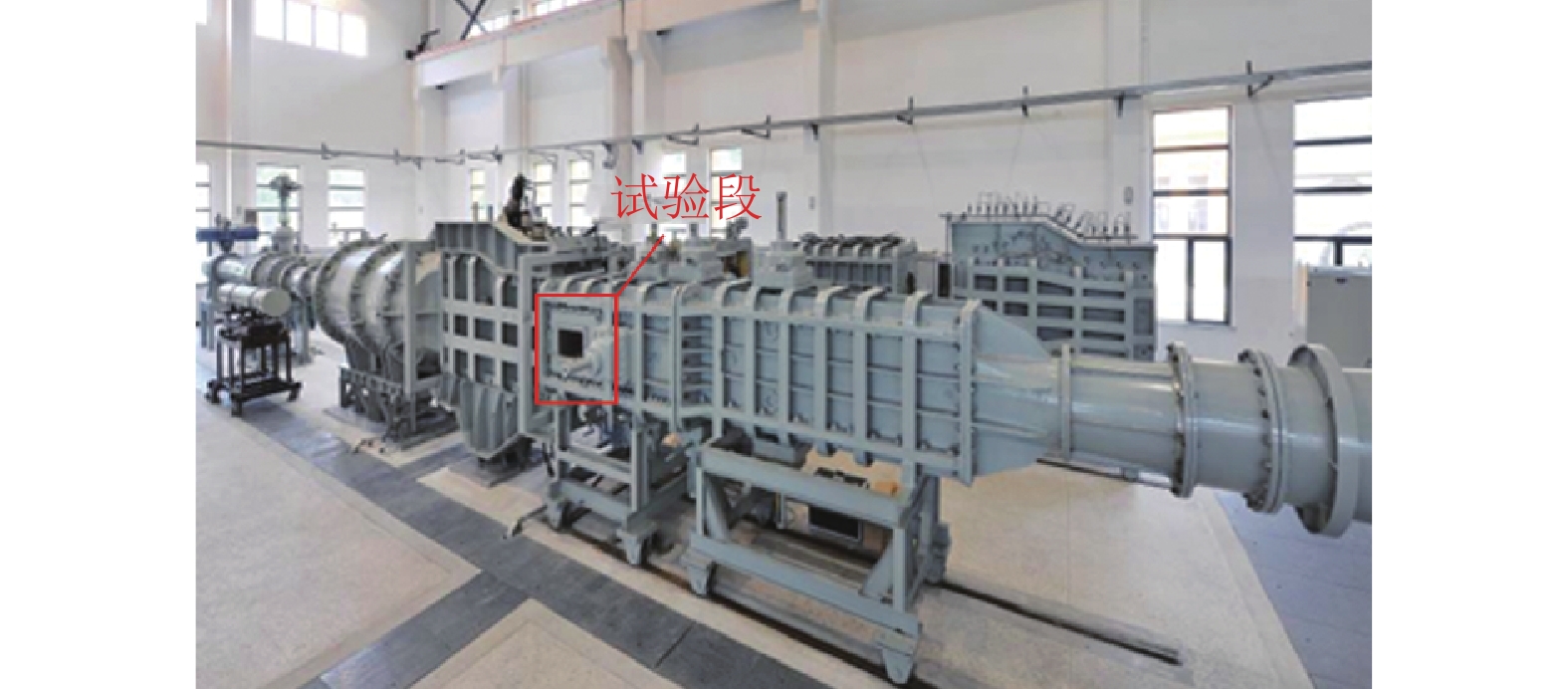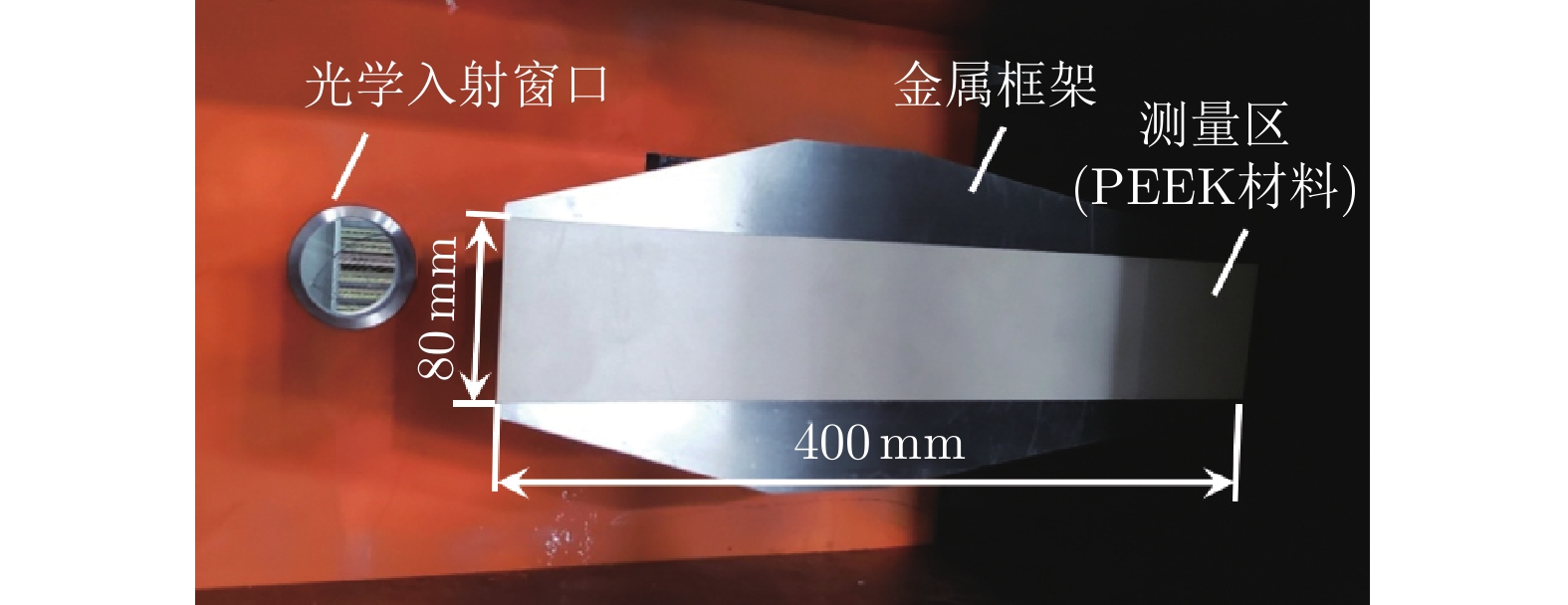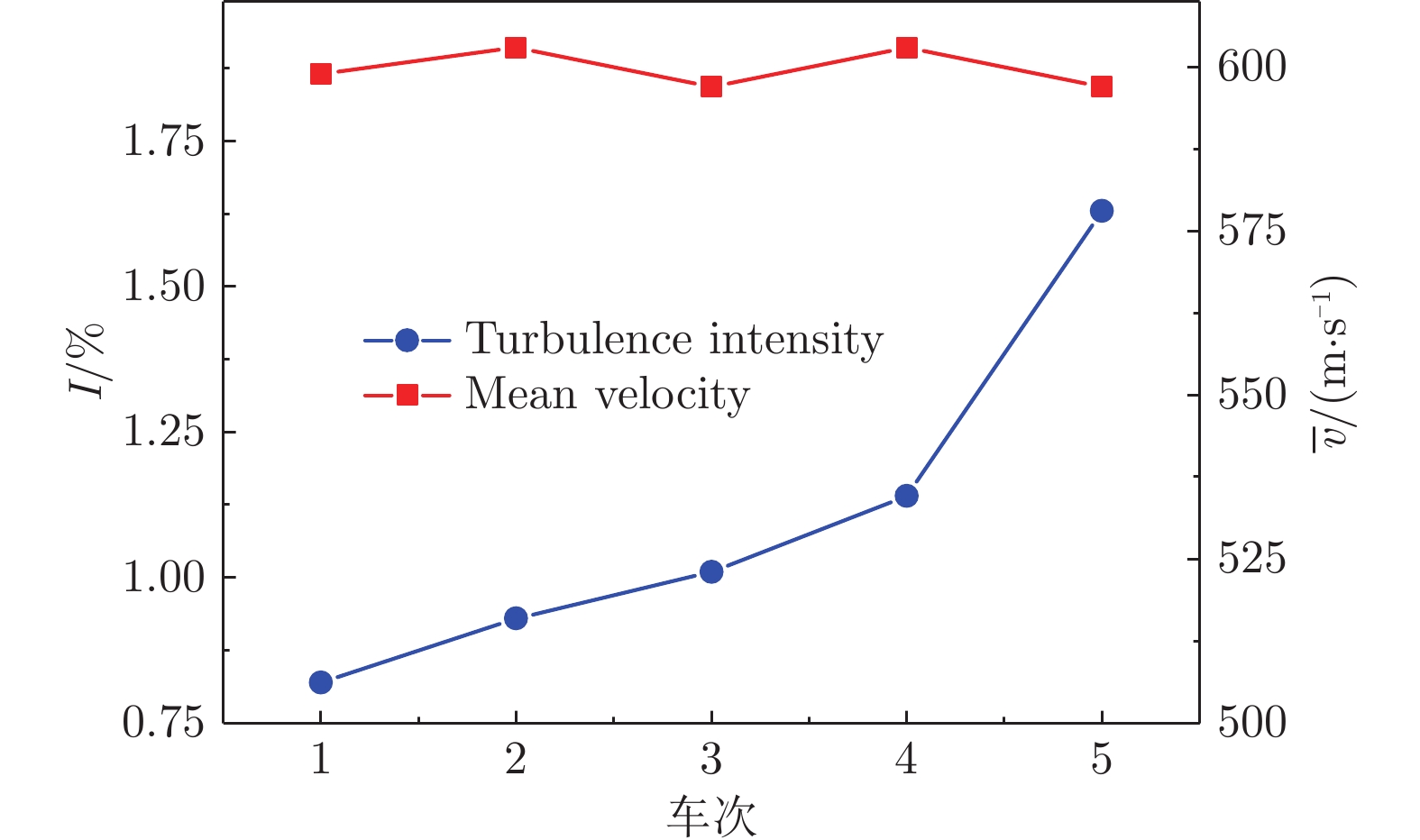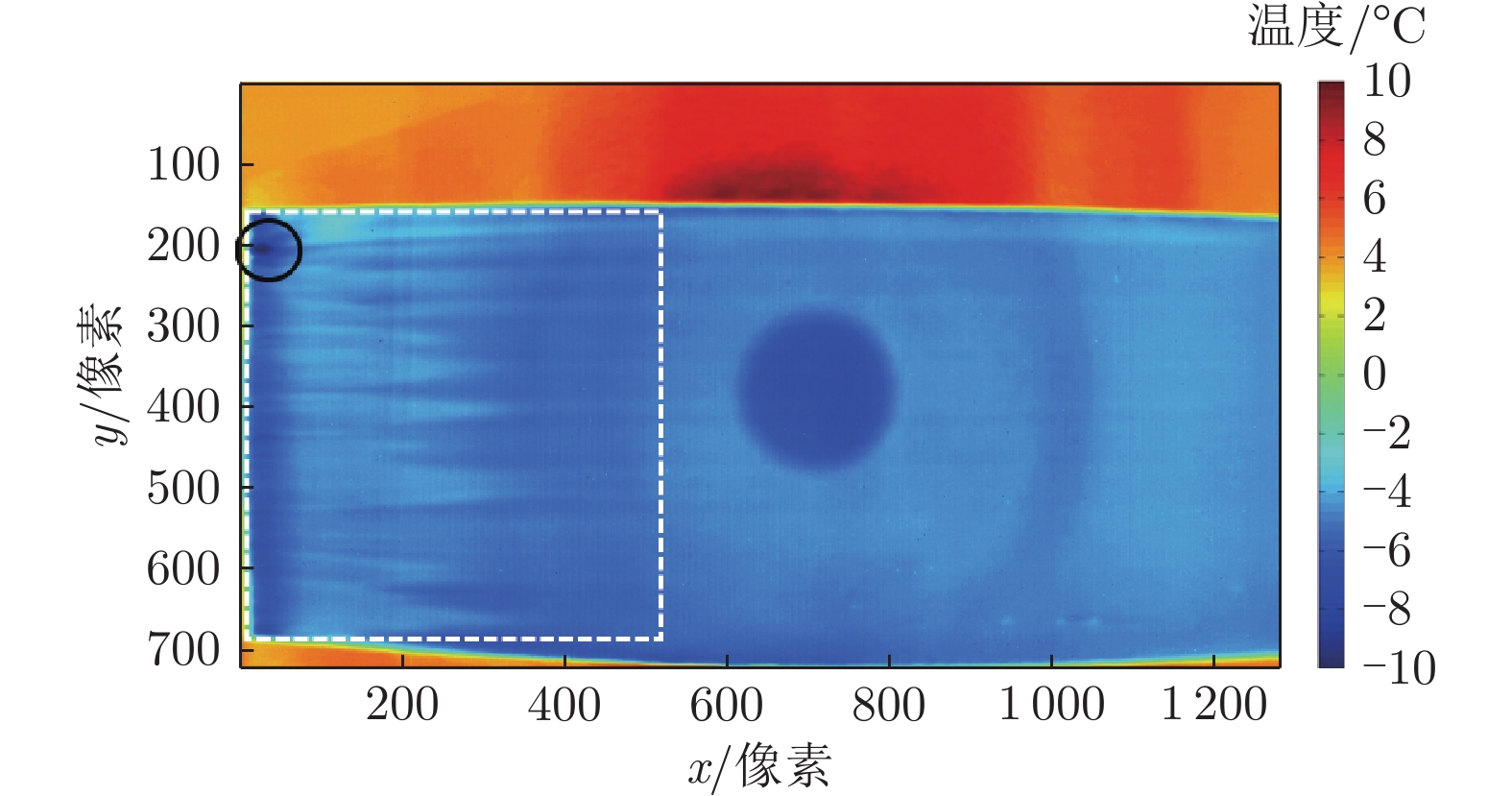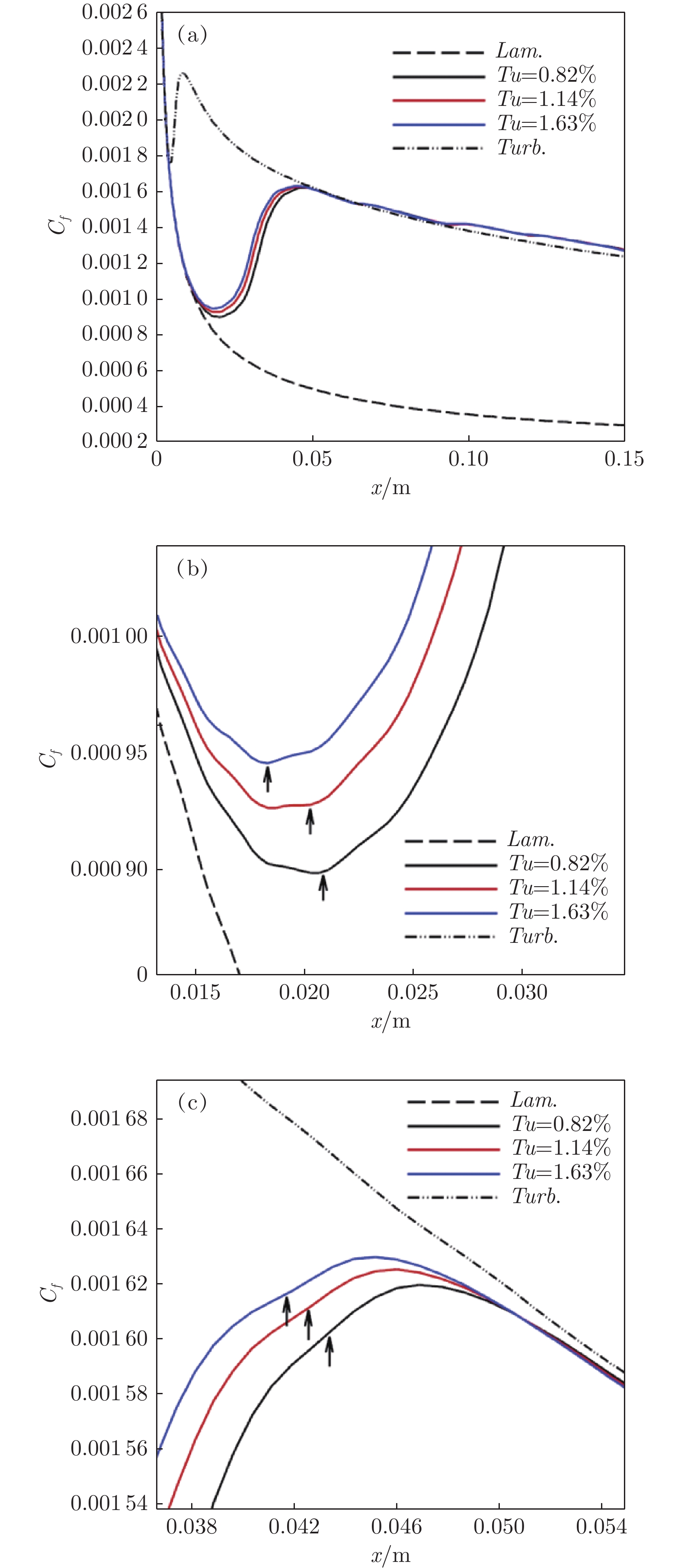Experimental research on the influence of turbulence intensity on boundary layer transition in Mach 3 supersonic flow
-
摘要:
针对超声速来流湍流度对转捩影响的风洞试验数据缺乏的现状,开展了马赫数3条件下不同来流湍流度对平板模型边界层转捩影响的试验研究。在中国空气动力研究与发展中心0.3 m × 0.3 m跨超声速风洞(FL–24y)内,通过改变风洞稳定段内的稳流参数,实现了来流湍流度在0.82%~1.63%范围内变化。利用干涉瑞利散射技术测量来流湍流度,利用红外热图技术测量平板模型表面温度分布,得到了来流湍流度对转捩起始和结束位置影响的试验数据。根据试验来流条件,采用γ–Reθ转捩模型对平板模型边界层转捩进行数值计算,并将计算结果与风洞试验数据进行对比。结果表明:平板模型转捩试验测量结果和数值计算结果符合较好,2种方法得到的转捩起始位置相对误差小于2%,转捩结束位置相对误差小于5%。本文试验结果可以为研究超声速来流湍流度对边界层转捩的影响规律提供数据支撑。
Abstract:There is still a shortage of the experimental research of boundary layer transition in compressible flows nowadays due to the difficulty in measuring the turbulence intensity. Aiming at studying the influence of the turbulence intensity on supersonic boundary layer transition, a plate model is tested in a blow-down facility (FL–24y of China Aerodynamics Research and Development Center) at Mach 3. The turbulence intensity of the flow is changed by adjusting the arrangements in the stabilization section of the wind tunnel, which covers a range from 0.82% to 1.63%. The turbulence intensity is measured by interferometric Rayleigh scattering, while the boundary layer transition is derived by infrared thermography. The CFD simulation of the plate model transition is conducted based on the γ–Reθ transition model. The results show that the transition onset position and transition end position obtained by the experiment and the simulation agree well, with the maximum relative error coefficient of 2% in the transition onset position and of 5% in the transition end position, which provides support to gain a deeper insight into the boundary layer transition mechanism in supersonic flows.
-
0 引 言
自20世纪50年代起,各国学者争相开展了隔离段内激波串的研究工作。“激波串”被表述为多个术语,如多支激波、激波系等。Waltrup与Billig[1-3]首次使用了“激波串”这一术语。“伪激波”概念最先由Crocco[4]提出:当隔离段长度足够时,在一系列激波串后存在一个混合区域,“伪激波”由激波串区域和混合区域共同构成。伪激波功能与一道正激波相似,由于隔离段内边界层的存在,激波与边界层相互作用后,形成了多道激波组成的激波串。对于“激波串”和“伪激波”这2个概念,它们所表达的侧重点不尽相同:当研究重点为正激波与边界层相互作用引起的一系列连续激波时,往往用“激波串”来表达;当关注“整个作用区域”充当一道正激波的作用时,通常用“伪激波”来表达。Waltrup与Billig[1]在研究一维超燃模型过程中,曾将预燃激波串结构假设为一道正激波或斜激波,但在超声速燃烧直连式风洞试验中发现预燃激波串结构是一系列斜激波,并且在隔离段内呈现不稳定状态。
为分析激波串的影响因素,学者们开展了一系列的研究。Ikui等[5]针对激波串结构随马赫数的变化过程做出了详细的描述。Hoeger等[6-7]对入口来流马赫数Ma∞=1.8、出口反压范围68.9~89.6 KPa条件下的隔离段内激波串进行了二维非定常数值模拟。反压的施加方式有瞬时施加和逐渐施加2种方式。当施加瞬时反压时,激波串形成并向隔离段上游移动,当达到收敛标准时,激波串向下游移动;当施加的瞬时反压减小时,激波串向上游推进的距离减小;瞬时施加反压与逐渐施加反压后激波串的位置一致。Balu等[8]对矩形隔离段进行实验研究发现,隔离段长高比介于4和5之间的隔离段最适合超声速燃烧。Crocco[4]指出,长高比决定着激波串混合区是否出现。金亮等[9]通过数值模拟发现,隔离段的长高比会影响反压与激波串起始位置之间的关系:当长高比为5和9.667时,激波串起始位置与反压呈线性关系;当长高比为20时,二者呈非线性关系。何粲[10]对矩形隔离段宽高比进行了研究分析,得出了“宽高比越大,伪激波前移的距离越长;小宽高比隔离段抗反压能力较强”的结论。Lin等[11]通过试验及计算研究了Ma∞=1.8和2.2条件下总温及壁面热传导对隔离段流场的影响,隔离段模型由吸热材料制成,试验中测量了隔离段壁面温度及静压,研究结果表明高总温流动产生的激波串相对更长。当壁温比流体温度低时,激波串长度变短,而高温壁面则会令激波串增长,使隔离段抗反压能力下降。Lin等[11]利用风洞试验研究了光滑隔热陶瓷材料和粗糙吸热材料对等截面隔离段内激波串特性的影响。在相同的隔离段长度和横截面积下,加装粗糙吸热材料矩形隔离段的抗反压能力弱于壁面光滑的隔离段,壁面粗糙度对隔离段的抗反压能力影响极大。
综上所述,目前的研究工作已对隔离段进出口条件中的反压比,隔离段构型中的长高比、宽高比、壁面条件等因素有了较为细致的分析,但针对隔离段进出口条件中的变马赫数来流条件以及隔离段构型中的变扩张角条件等因素还没有开展工作,本文对以上2种因素进行系统研究。此外,本文还考虑了2种可能存在激波串与壁面凹腔相互作用的情况,研究了壁面凹腔对隔离段内激波串特性的影响。
1 计算模型及数值模拟方法
1.1 计算模型
本文采用的物理模型为矩形等直隔离段,尺寸参考Di Stefano等[12]在试验中所采用的构型,隔离段整体长度为609.6 mm,高度为25.4 mm,宽度为50.8 mm,宽高比为2。凹腔结构采用长深比为4的开式凹腔,长度为40.0 mm,高度为10.0 mm。
模型尺寸及坐标系如图1所示,标红部分为本文中关注的3种主要因素,即来流马赫数Ma∞、扩张角θ及壁面凹腔。当对来流马赫数产生的影响进行研究时,所采用的构型为等直隔离段构型;当对扩张角进行研究时,需在保持隔离段水平长度及入口截面参数不变的前提下改变出口截面参数,以达到改变隔离段整体扩张角的目的;当对壁面凹腔进行研究时,可通过在等直隔离段上添加壁面凹腔来实现。由于构型具有对称性,在计算对称扩张角、对称凹腔等完全对称构型时采用1/4构型,在单侧扩张角构型等非对称构型计算时采用1/2构型。
1.2 数值模拟方法及算例验证
随着计算流体力学的发展,目前有3种较为成熟的数值模拟方法,即雷诺平均N–S方程模拟(RANS)、直接数值模拟(DNS)和大涡模拟(LES)。本文采用RANS方法,该方法相较于直接数值模拟和大涡模拟,具有计算量较小(便于开展参数研究)且精度也能满足研究需要的优势,可大幅节约计算时间和成本。目前的湍流模型主要有
$ k - \omega $ 模型和$ k - \varepsilon $ 模型,其中标准$ k - \varepsilon $ 模型因忽略分子黏性而适用于距壁面处有一定距离的主流区域,而标准$ k - \omega $ 模型则在壁面处计算表现更好,故研究者提出一种新的湍流模型,即$ k - \omega $ SST模型。$ k - \omega $ SST模型兼具标准$ k - \omega $ 模型和标准$ k - \varepsilon $ 模型这2种模型的优势,在壁面及主流区域的计算效果均较为良好。本文采用$ k - \omega $ SST模型,求解器采用密度基、定常、隐式格式求解,时间推进采用二阶隐式瞬态方程,黏性项为Sutherland公式,流通量采用Roe–FDS格式,对流项与湍流项均采用二阶迎风格式。为验证数值模拟方法和模型对模拟激波串结构的适用性,通过对比Di Stefano等[12]在NASA隔离段动力学研究室所得壁面压力试验数据并利用
$ k - \omega $ SST模型在与试验相同的条件下进行数值模拟所得壁面压力数据进行算例验证。试验条件为:Ma∞= 2.5,来流总压 p∞=861.85 kPa ,来流总温T∞= 298.15 K,出口静压 pout=311.556 kPa。本文采用三维数值模拟,入口条件设置为压力入口,出口条件设置为压力出口,壁面采用绝热无滑移壁面,总网格量约为135万。提取试验及数值模拟所得壁面压力比值(p/p')曲线如图2所示,其中p为流场的壁面压力,p'为入口的壁面压力。从图中可以看出,受测点数目限制,试验所得壁面压力比值数据点振荡不太明显,而数值模拟所得壁面压力比值曲线受激波串的影响产生明显振荡现象。数值模拟与试验所得的壁面压力升高起始位置以及整体趋势基本相同,验证了本文所采用的数值模拟方法的可行性。
1.3 网格无关性验证
为验证数值模拟方法、模型及网格划分是否满足计算要求,以p∞=1.60 MPa、T∞=1400 K、Ma∞=2.5、反压比(pout/pin,pin为入口静压)为3.5的工况进行网格无关性验证。利用Pointwise软件分别做细、中、粗3种不同网格量的网格,流向网格均匀布置,法向网格在壁面处进行加密处理(第一层网格高度为0.01 mm);粗网格主流网格量约为57万,中网格主流网格量约为135万,细网格主流网格量约为245万。
为进一步比较3种网格条件下的流场计算结果,图3给出了流场马赫数Ma及壁面压力p云图。从图中可以看出,细、中网格云图和粗网格云图存在差异:粗网格云图中激波串结构向入口推进的距离明显更长,且第一道激波中心处无亚声速区出现;而细、中网格云图中激波串结构基本一致,且第一道激波中心处出现了亚声速区。
图4为3种网格条件下流场壁面压力比值曲线。从图中可以看出,粗网格条件下的曲线与细、中网格条件下明显不同,而细、中网格条件下的曲线基本一致,由此可证明网格无关性。基于计算时间及成本,本文利用中网格进行计算。
2 不同因素对隔离段内激波串特性的影响
对来流马赫数、扩张角及壁面凹腔3种因素条件下的工况进行设置,如表1所示。在对影响因素进行研究时,主要基于隔离段构型,忽略了燃烧室段复杂的燃烧流动以及激波串和燃烧的相互作用过程,故在隔离段出口添加一个有效反压,近似模拟下游燃烧室的影响,简化了研究问题。通过分析不同条件下隔离段流场中的激波串特性以及参数变化,得到燃烧室入口参数的变化规律,并以此评估不同隔离段的性能,为燃烧室设计提供参考。
表 1 算例设置表Table 1 Table of calculation examples算例 Ma∞ $ \theta $ 反压比 壁面凹腔 1 2.5、2.7、3.0 0° 6.0 无 2 2.5 0° 3.5/4.0/4.5/5.0 无 3 2.5 1°/2°/3°/4°(对称) 5.0 无 4 2.5 1°/2°(单侧) 5.0 无 5 2.5 0° 3.5/4.0/4.5/5.0 有 2.1 马赫数对激波串特性的影响
通过保持p∞不变、改变pin的方式来改变Ma∞,研究不同来流马赫数(Ma∞=2.5、2.7和3.0)对激波串特性的影响。算例1的数值模拟结果如图5所示。对结果进行测量计算后发现,随着Ma∞的增大,激波串第一道激波倾角发生了明显变化:当Ma∞=2.5时,第一道激波倾角约为32.7°;当Ma∞增大至2.7时,第一道激波倾角约减小为25.9°;当Ma∞达到3.0时,第一道激波倾角已减小至21.0°。随着Ma∞的增大,第一、二道激波距离逐渐增大,激波串结构向入口推进的距离减小,说明随着Ma∞的增大,隔离段的抗反压能力逐渐增强。
为定量比较不同Ma∞对流场各参数的影响,提取算例1流场中的参数进行分析,结果如图6所示。从图中可以看出,当反压比一定时,随着Ma∞增大,流场中壁面压力升高起始位置及马赫数下降的突变起始位置逐渐向出口移动,曲线振荡幅度减小、振荡次数减小,说明流场中激波串位置随Ma∞的增大逐渐向出口移动,波节数目随着Ma∞的增大而减少,激波串中激波边界层干扰强度减弱,Ma∞越高,流场总压p0损失越大。
综上所述,在反压比一定的情况下,随着Ma∞的增大,第一道激波倾角逐渐减小,波节数目减少,波节之间的距离变长,激波串向前推进的距离变短,从而流场中壁面压力及马赫数等参数振荡位置逐渐靠后,振荡次数逐渐减少,隔离段抗反压能力增强。
高来流马赫数条件下的隔离段抗反压能力固然较强,来流静温静压较低,但隔离段内流场总压损失增大,不利于燃烧室中燃烧的组织,故在进行燃烧室设计时,应结合来流马赫数条件和燃烧室中燃烧的组织情况进行综合考虑。
2.2 扩张角对激波串特性的影响
隔离段上下壁面扩张角是影响激波串特性不可忽视的因素。本文通过对算例3和4进行数值模拟,分析扩张角对激波串特性的影响。
2.2.1 对称扩张角
算例3(隔离段对称扩张角分别为1°、2°、3°和4°)的数值模拟结果如图7所示。可以看出,随着扩张角的增大,激波串结构向隔离段入口推进,激波串后混合区逐渐变长,相较于等直隔离段(θ=0°),第一道激波形状未发生明显变化(激波角约35°)。隔离段扩张角的增大使得激波串波节数目减少、长度变短(扩张角分别为1°、2°、3°和4°时,测得激波串结构的长度分别为:0.301、0.293、0.268和0.242 m)。
为定量分析不同扩张角下隔离段内流场参数的特点,提取算例3流场的壁面压力、马赫数、总压及出口马赫数(Maout)等参数进行分析,如图8所示。从图中可以看出:随着扩张角的增大,相比于等直隔离段,壁面压力呈现出先下降、后振荡上升的趋势,马赫数则先上升、后振荡下降,且扩张角越大,壁面压力下降和马赫数增大的幅值越大;扩张角增大,曲线的波峰波谷数目减少,振幅逐渐减小,在扩张角为4°时已基本无明显振荡现象;在扩张角增大的同时,壁面压力整体升高,马赫数减小;随着扩张角的增大,流场总压损失逐渐增大,出口马赫数逐渐减小,说明流场中激波串强度逐渐增强。
综上所述,在反压比及来流马赫数不变的情况下,对称扩张角的增大不会改变激波串形态,但会改变激波串长度及波节数目(随扩张角的增大,激波串长度变短,波节数目减少),从而导致流场中各参数的振荡次数减少、振荡幅度减小、流场总压损失增大、出口马赫数减小。
2.2.2 单侧扩张角
为与对称扩张隔离段(算例3)进行对比分析,本文研究了单侧壁面扩张构型。图9给出了算例4(单侧扩张角为1°和2°)和算例3(对称扩张角为1°和2°)的数值模拟结果对比。当隔离段为上壁面等直、下壁面扩张角为1°和2°时,隔离段内流场呈现出明显的非对称性:当扩张角为1°时,上壁面边界层分离区大于下壁面边界层分离区,当扩张角为2°时则正好相反。观察流场中激波串结构可以看出,在相同反压比条件下,单侧扩张隔离段内流场呈现出激波触壁面反射的状态,激波反射的现象主要出现在边界层分离区较小的壁面处;相比于对称壁面扩张构型,单侧壁面扩张构型内的激波向入口推进的距离更长,说明单侧扩张隔离段比对称扩张隔离段抗反压能力更弱。
为定量比较算例4(单侧扩张角为 1°和 2°)和算例3(对称扩张角为1°和 2°)两者流场的差别,提取各工况条件上下壁面压力及总压进行对比,结果如图10~12所示。
从图10可以看出,当反压比为5时:单侧扩张角为1°时的上壁面压力起始位置相比于下壁面压力及对称扩张角为1°时的壁面压力显著提前;在单侧扩张角为2°工况下,则是下壁面压力起始位置显著提前于上壁面压力及对称扩张角为2°时的壁面压力,证明了在单侧扩张角情况下流场存在非对称现象。在单侧扩张角所形成的非对称流场中,边界层分离区较大的一侧因激波无法反射至壁面,使得壁面压力几乎无振荡,而边界层分离区较小的一侧壁面压力则出现明显振荡现象,且振荡幅值及次数显著高于对称扩张角情况下的壁面压力。从图11可以看出,隔离段单侧扩张角增大,上下壁面压力显著升高,振荡位置提前,这与前文对称扩张隔离段的扩张角增大时所得结论相似。图12展示了各工况下的总压变化曲线,可以看出,当扩张角为1°时,由于流场的非对称性,单侧和对称扩张隔离段的总压下降突变起始位置和扩张隔离段有所区别,但整体趋势基本一致,最终总压基本相等。分析扩张角为2°时的单侧和对称扩张隔离段总压曲线可以看出,单侧扩张隔离段总压下降的突变起始位置靠前,趋于收敛位置也同样靠前,但总体趋势与对称扩张隔离段相似,最终的总压也基本相等。
综上所述,单侧扩张角构型的流场呈非对称,当扩张角为1°时,流场中上壁面分离区大于下壁面,当扩张角为2°时则与1°时相反,即下壁面分离区大于上壁面;同时,在单侧扩张角构型中,流场中呈现的并非激波串结构,而是激波撞击壁面反射的现象,且壁面边界层分离区较大的壁面压力几乎无振荡,分离区较小的壁面压力振荡较强,明显强于对称扩张角构型。对于扩张隔离段,无论是单侧扩张角构型还是对称扩张角构型,扩张角的增大均会使得流场总压损失增大。在相同扩张角条件下,单侧扩张角隔离段和对称扩张角隔离段流场总压的沿程变化有所区别,但出口总压基本保持一致,即隔离段后燃烧室入口总压基本保持一致。由此可以推断,在相同扩张角条件下,采用单侧或对称扩张形式并不会改变隔离段出口总压值。
因扩张角增大会导致隔离段出口总压损失增大,在实际燃烧室设计过程中应避免使用扩张型隔离段。如需对扩张隔离段的燃烧室进行设计,由于隔离段的扩张角已经确定,应着重考虑隔离段的扩张形式。经前文分析,扩张形式并不会改变隔离段出口总压值,对燃烧室而言,其入口来流条件基本相同,但单侧扩张角隔离段内激波串抗反压能力较差,在设计扩张型隔离段时应尽量采用对称扩张隔离段。
2.3 壁面凹腔对激波串特性的影响
壁面凹腔是燃烧室中较为重要的结构,具有增强掺混、稳定火焰的作用。处于超声速气流中的壁面凹腔流动涉及回流区、边界层、激波和膨胀波等多种结构。相比于等直隔离段和扩张隔离段,带壁面凹腔的隔离段内激波串结构的形成更为复杂。研究壁面凹腔对隔离段的影响主要基于2种考虑:一是在隔离段内增加壁面凹腔结构可增强燃料掺混,提高下游燃烧室的燃烧效率,该结论已在Quick等[13]的研究中提及;二是在宽范围多壁面凹腔燃烧室中,低马赫数条件下可能会在下游壁面凹腔处组织燃烧,上游壁面凹腔所在的燃烧室段实际上变成了隔离段的一部分。因此,有必要分析带壁面凹腔的隔离段流场中激波串特性及各参数的变化规律。本文研究构型如图13所示,红色框内为计算区域,因燃烧产生的复杂反压条件则以设置出口反压的方式进行简化,本文并不关注激波串和燃烧的直接作用(后续再开展研究)。对算例5(有壁面凹腔,反压比分别为3.5、4.0、4.5、5.0)进行计算,得到的马赫数云图如图14所示。
从马赫数云图中可以看出:当反压比从3.5增加至4.5时,流场中所形成的激波串结构波节之间距离减小,激波更为密集;而反压比增至5.0时(即反压比已足够将激波串推至壁面凹腔结构上游),激波串形态变得明显不同。为更清晰地了解激波串在经过壁面凹腔前后的变化,取激波串位于壁面凹腔前后的2种典型工况(即反压比4.5和5.0工况)分别与算例2中不带壁面凹腔的等直隔离段工况进行对比,结果如图15所示。
从图15可以看出,当反压比为4.5时,带壁面凹腔隔离段和无壁面凹腔隔离段内激波串结构差异较大。带壁面凹腔隔离段内激波串第一道激波出现在壁面凹腔处,为一道“X”形激波,随后激波串因边界层持续加厚逐渐变得模糊,但激波串波节数目仍和无壁面凹腔隔离段保持一致;而当反压比为5.0时,流场中激波串第一、二道激波呈现出清晰的X形结构,且其激波形态与无壁面凹腔隔离段内激波形态基本相同,随后第三道激波出现在壁面凹腔内部,同样为X形结构,后续激波串为几道X形激波叠加在一起,之后流场中上下壁面边界层逐渐靠近,流场中无明显激波串结构存在。激波串在经过壁面凹腔后向入口推进距离明显增大,远超于相同反压条件下的无壁面凹腔结构,此时隔离段抗反压能力显著下降。
为方便表述,根据数值模拟结果将激波串第一道激波位置未超过壁面凹腔后缘的模态命名为“亚临界凹腔模态”,第一道激波位置超过壁面凹腔前缘的模态命名为“超临界凹腔模态”。为研究这2种模态出现的原因,提取流场中超声速区域流通面积S变化曲线及流场中Ma=1等值面云图,如图16、17所示。
从图16、17可以看出,流场中超声速区域流通面积变化趋势是振荡下降的,振荡起始位置与第一道激波位置相同。在亚临界凹腔模态下,相比于无壁面凹腔隔离段,带壁面凹腔隔离段内超声速区域流通面积相对较小,流场中分离区呈扁平状,其超声速区域流通面积较大,流场中分离区呈方形,说明在亚临界凹腔模态下,壁面凹腔边界层与激波串相互作用较弱,主要作用为增厚凹腔后段边界层,流场中低速区(Ma<1)较大。当反压比为5.0时,带壁面凹腔隔离段流场超声速区域流通面积显著小于无壁面凹腔隔离段,振荡起始位置显著提前,分离区形态与无壁面凹腔隔离段相似,长度却较长,其原因为:在高反压条件下,壁面凹腔边界层与激波串的相互作用增强,超声速区域流通面积减小,激波串受扰动向入口推进距离更长,流场中边界层分离区增大。
为定量分析2种模态条件下矩形隔离段内流场主要参数的变化规律,提取算例5的壁面及中心压力并与算例2进行对比,如图18所示,其中,pz为流场中心压力,p'z为入口的中心压力。从图中可以看出,当反压比为3.5、4.0和4.5时,带壁面凹腔隔离段内壁面及中心压力虽在壁面凹腔处有较小波动,但主要起振位置与无壁面凹腔隔离段近似,且前者壁面和中心压力大小及振荡幅度弱于后者,激波串位于壁面凹腔结构下游,说明当流场处于亚临界凹腔模态时,壁面凹腔结构仅影响到了压力振荡的强度,对压力变化的位置没有造成明显的影响。在反压比为5.0的条件下,流场处于超临界凹腔模态,此时带壁面凹腔隔离段流场压力起振位置明显提前,中心压力强度仍然弱于无壁面凹腔隔离段,壁面压力则整体较高。
为进一步分析2种模态条件下流场温度T、马赫数以及总压变化规律,对反压比为4.5和5.0时的2种典型工况进行比较,提取算例5和2的流场参数如图19所示。从图中可以看出,当反压比为4.5时,带壁面凹腔隔离段内流场处于亚临界凹腔模态,流场温度、马赫数及总压曲线振荡幅度及趋势基本相同,区别在于曲线起振位置存在差异,且带壁面凹腔隔离段出口处流场温度、马赫数以及总压与无壁面凹腔隔离段基本相同,说明在亚临界凹腔模态下,壁面凹腔结构并不会影响隔离段流场出口参数大小。当反压比升高至5.0时,带壁面凹腔隔离段内流场处于超临界凹腔模态,此时流场各参数曲线起振位置大幅提前,但振荡幅度及次数显著少于无壁面凹腔隔离段,说明此时流场中激波串强度较弱。带壁面凹腔隔离段内流场整体温度和出口温度均高于相同反压比条件下无壁面凹腔隔离段,流场整体马赫数及总压均低于无壁面凹腔隔离段 ,但出口马赫数基本相同,出口总压值则较低,说明在超临界凹腔模态下,壁面凹腔结构的存在使得流场整体温度升高,总压损失增大,但并不会影响流场出口马赫数。经过对上述参数的分析可以看出,当带壁面凹腔隔离段处于不同壁面凹腔模态时,流场各参数相比于无壁面凹腔隔离段会出现不同的变化。
综上所述,在亚临界凹腔模态下,流场中激波串结构与无壁面凹腔隔离段构型明显不同,激波形状主要呈X形,且流场中壁面及中心压力均低于无壁面凹腔隔离段构型,但压力起振位置基本与无壁面凹腔隔离段构型相似,说明在亚临界凹腔模态下,壁面凹腔结构改变了激波串形态,但没有改变隔离段的整体抗反压能力;对于超临界凹腔模态,流场中前几道激波形态与无壁面凹腔隔离段构型相似,之后边界层逐渐增厚,流场各参数起振位置显著提前,振荡幅度均弱于无壁面凹腔隔离段构型,隔离段整体抗反压能力下降;相较于亚临界凹腔模态,超临界凹腔模态下的流场温度较高,总压损失增大,但出口马赫数仍保持相同。
在实际隔离段设计中,当需要添加壁面凹腔以增强掺混、提高燃烧效率时,需同时考虑壁面凹腔所在位置以及燃烧时产生的反压,使隔离段内流场尽量出现亚临界凹腔模态,避免出现超临界凹腔模态,因为在超临界凹腔模态下,隔离段抗反压能力大幅下降,会影响到下游燃烧室的工作,降低发动机性能。对宽范围工作的多凹腔燃烧室进行设计时,在低马赫数下需要在下游凹腔组织燃烧,燃烧反压引起的激波串将与上游凹腔产生相互作用,此时可能出现亚临界凹腔及超临界凹腔2种模态,导致不同的激波串特性及反压前传特性,故应在组织燃烧设计时进行相应考虑。
3 结 论
本文在矩形隔离段内通过数值模拟方法研究了马赫数、隔离段扩张角、壁面凹腔对流场中激波串特性的影响,结论如下:
1)在反压比相同时,来流马赫数升高,激波串向入口推进的距离缩短,隔离段整体抗反压能力增强,总压损失升高。在总压不变的条件下,高来流马赫数虽然会使得隔离段整体抗反压能力增强,但伴随而来的低静温静压以及总压损失会对燃烧室内燃烧组织产生负面影响,在实际对燃烧室进行设计时应综合考虑隔离段的抗反压能力及燃烧室组织燃烧的难易来设计来流马赫数。
2)当对称扩张隔离段的扩张角增大时,激波串向入口推进距离变长,激波串整体长度变短,流场中压力升高,马赫数降低;而在单侧扩张隔离段构型中,所形成的流场为非对称流场,增大扩张角会使得流场分离区发生改变,相比于对称扩张角,单侧扩张角隔离段内激波串向前推进距离更长,抗反压能力更弱。无论是单侧还是对称扩张隔离段构型,增大扩张角均会使得总压损失增大, 但在相同扩张角条件下,单侧扩张隔离段和对称扩张隔离段的总压损失基本相同。在实际燃烧室设计过程中,如需采用扩张隔离段,应尽量采用对称扩张隔离段。
3)出现亚临界凹腔模态和超临界凹腔模态的本质原因在于激波串在未经过壁面凹腔时激波与壁面凹腔边界层相互作用较弱,在经过壁面凹腔后流场中超声速区域流通面积大幅减小,激波串受扰动向入口推进距离更长。在亚临界凹腔模态下,壁面凹腔结构改变了激波串形态使得流场中压力降低,但基本不改变构型的抗反压特性;在超临界凹腔模态下,流场中压力振荡起始位置显著提前,抗反压能力下降,且不同模态条件下壁面凹腔结构对流场参数变化的影响不同,超临界凹腔模态下流场总压损失较大。当隔离段设计需要添加壁面凹腔以增强掺混时,应对壁面凹腔位置以及燃烧组织进行设计,避免在隔离段内出现超临界凹腔模态;而在多凹腔燃烧室中,壁面凹腔和下游激波串相互作用可能出现以上2种模态,应在组织燃烧设计时进行考虑。
-
表 1 试验参数
Table 1 Flow conditions
工况 烧结丝网层数 阻尼网层数 pt/kPa Tt/K 1 2 5 470 293 2 2 3 471 293 3 1 5 470 293 4 1 3 470 293 5 0 5 471 293 表 2 试验结果与数值计算结果对比
Table 2 Comparison between experimental result and CFD simulation
I Fonset Fend 试验值/mm 计算值/mm e 试验值/mm 计算值/mm e 0.82% 21.29 20.87 −1.97% 43.88 43.34 −1.23% 1.14% 20.54 20.26 −1.36% 41.93 42.52 1.41% 1.63% 17.92 18.27 1.95% 39.83 41.67 4.62% 注:相对误差e = (计算值 − 试验值) / 试验值 × 100% -
[1] 张扣立, 常雨, 孔荣宗, 等. 温敏漆技术及其在边界层转捩测量中的应用[J]. 宇航学报, 2013, 34(6): 860–865. ZHANG K L, CHANG Y, KONG R Z, et al. Temperature sensitive paint technique and its application in measurement of boundary layer transition[J]. Journal of Astronautics, 2013, 34(6): 860–865.
[2] 刘向宏, 赖光伟, 吴杰. 高超声速边界层转捩实验综述[J]. 空气动力学学报, 2018, 36(2): 196–212. DOI: 10.7638/kqdlxxb-2018.0017 LIU X H, LAI G W, WU J. Boundary-layer transition experiments in hypersonic flow[J]. Acta Aerodynamica Sinica, 2018, 36(2): 196–212. doi: 10.7638/kqdlxxb-2018.0017
[3] 陈坚强, 涂国华, 张毅锋, 等. 高超声速边界层转捩研究现状与发展趋势[J]. 空气动力学学报, 2017, 35(3): 311–337. DOI: 10.7638/kqdlxxb-2017.0030 CHEN J Q, TU G H, ZHANG Y F, et al. Hypersnonic boundary layer transition: what we know, where shall we go[J]. Acta Aerodynamica Sinica, 2017, 35(3): 311–337. doi: 10.7638/kqdlxxb-2017.0030
[4] LANGTRY R B, MENTER F R. Correlation-based transition modeling for unstructured parallelized computa-tional fluid dynamics codes[J]. AIAA Journal, 2009, 47(12): 2894–2906. doi: 10.2514/1.42362
[5] LANGTRY R B, SENUPTA K, YEH D T, et al. Extending the γ–Reθt local correlation based transition model for crossflow effects[R]. AIAA-2015-2474, 2015. doi: 10.2514/6.2015-2474
[6] ABU-GHANNAM B J, SHAW R. Natural transition of boundary layers—the effects of turbulence, pressure gradient, and flow history[J]. Journal of Mechanical Engineering Science, 1980, 22(5): 213–228. doi: 10.1243/jmes_jour_1980_022_043_02
[7] 袁湘江, 沙心国, 时晓天, 等. 高超声速流动中噪声与湍流度的关系[J]. 航空学报, 2020, 41(11): 123791. YUAN X J, SHA X G, SHI X T, et al. Noise-turbulence relationship in hypersonic flow[J]. Acta Aeronautica et Astronautica Sinica, 2020, 41(11): 123791.
[8] SCHNEIDER S P. Flight data for boundary-layer transition at hypersonic and supersonic speeds[J]. Journal of Spacecraft and Rockets, 1999, 36(1): 8–20. doi: 10.2514/2.3428
[9] 盛森芝, 徐月亭, 袁辉靖. 热线热膜流速计[M]. 北京: 中国科学技术出版社, 2003. SHENG S Z, XU Y T, YUAN H J. Hot-wire hot-film anemometer[M]. Beijing: China Science and Technology Press, 2003.
[10] 王彦植, 陈方, 刘洪, 等. 高速流动PIV示踪粒子跟随响应特性实验研究[J]. 实验流体力学, 2018, 32(3): 94–99. DOI: 10.11729/syltlx20170160 WANG Y Z, CHEN F, LIU H, et al. Experimental investigation on response characteristics of PIV tracer particles in high speed flow[J]. Journal of Experiments in Fluid Mechanics, 2018, 32(3): 94–99. doi: 10.11729/syltlx20170160
[11] SEASHOLTZ R G, BUGGELE A E, REEDER M F. Flow measurements based on Rayleigh scattering and Fabry-Perot interferometer[J]. Optics and Lasers in Engineering, 1997, 27(6): 543–570. doi: 10.1016/S0143-8166(96)00063-2
[12] FAGAN A F, ZAMAN K Q, ELAM K. Two-point dynamic Rayleigh scattering measurements in a free jet[C]//Proc of the 32nd AIAA Aerodynamic Measurement Technology and Ground Testing Conference. 2016. doi: 10.2514/6.2016-3109
[13] CHEN L, YANG F R, SU T, et al. High sampling-rate measurement of turbulence velocity fluctuations in Mach 1.8 Laval jet using interferometric Rayleigh scattering[J]. Chinese Physics B, 2017, 26(2): 345–348.
[14] 杨富荣, 陈力, 闫博, 等. 干涉瑞利散射测速技术在跨超声速风洞的湍流度测试应用研究[J]. 实验流体力学, 2018, 32(3): 82–86. DOI: 10.11729/syltlx20170103 YANG F R, CHEN L, YAN B, et al. Measurement of turbulence velocity fluctuations in transonic wind tunnel using Interferometric Rayleigh Scattering diagnostic technique[J]. Journal of Experiments in Fluid Mechanics, 2018, 32(3): 82–86. doi: 10.11729/syltlx20170103
[15] 陈爱国, 陈力, 李志辉, 等. 瑞利散射测速技术在高超声速流场中应用研究[J]. 实验流体力学, 2017, 31(6): 51–55. DOI: 10.11729/syltlx20170020 CHEN A G, CHEN L, LI Z H, et al. Research on application of Rayleigh scattering velocity measurement in hypersonic low density wind tunnel[J]. Journal of Experiments in Fluid Mechanics, 2017, 31(6): 51–55. doi: 10.11729/syltlx20170020
[16] ZUCCHER S, SARIC W S. Infrared thermography investigations in transitional supersonic boundary layers[J]. Experiments in Fluids, 2008, 44(1): 145–157. doi: 10.1007/s00348-007-0384-1
[17] MERTENS C, WOLF C C, GARDNER A D, et al. Advanced infrared thermography data analysis for unsteady boundary layer transition detection[J]. Measurement Science and Technology, 2020, 31(1): 015301. doi: 10.1088/1361-6501/ab3ae2
[18] 耿子海, 何显中, 王勋年, 等. 红外成像非接触转捩测量低速风洞试验技术研究[J]. 实验流体力学, 2010, 24(6): 77–82. DOI: 10.3969/j.issn.1672-9897.2010.06.017 GENG Z H, HE X Z, WANG X N, et al. Non-intrusive test technique investigation of transition measurement with infrared image in low speed wind tunnel[J]. Journal of Experiments in Fluid Mechanics, 2010, 24(6): 77–82. doi: 10.3969/j.issn.1672-9897.2010.06.017
[19] YOON S, JAMESON A. Lower-upper Symmetric-Gauss-Seidel method for the Euler and Navier-Stokes equations[J]. AIAA Journal, 1988, 26(9): 1025–1026. doi: 10.2514/3.10007
[20] KIM K H, KIM C, RHO O H. Methods for the accurate computations of hypersonic flows[J]. Journal of Computa-tional Physics, 2001, 174(1): 38–80. doi: 10.1006/jcph.2001.6873
[21] ANDERSON W K, THOMAS J L, VAN LEER B. Comparison of finite volume flux vector splittings for the Euler equations[J]. AIAA Journal, 1986, 24(9): 1453–1460. doi: 10.2514/3.9465
[22] 沙心国, 郭跃, 纪锋, 等. 高超声速圆锥边界层失稳条纹结构实验研究[J]. 空气动力学学报, 2020, 38(1): 143–147. DOI: 10.7638/kqdlxxb-2019.0141 SHA X G, GUO Y, JI F, et al. Experimental study on instability streak structure over a hypersonic cone[J]. Acta Aerodynamica Sinica, 2020, 38(1): 143–147. doi: 10.7638/kqdlxxb-2019.0141
-
期刊类型引用(2)
1. 浮强,冯泽溪,李昊轩. 长高比对隔离段激波串特性的影响研究. 郑州航空工业管理学院学报. 2025(01): 10-17 .  百度学术
百度学术
2. 吴鑫罡,郑权,黄亚坤,翁春生. 旋转爆轰冲压发动机隔离段构型对其抗反压特性影响研究. 南京理工大学学报. 2025(01): 113-124 .  百度学术
百度学术
其他类型引用(1)







 下载:
下载:




























